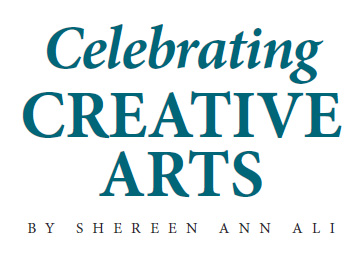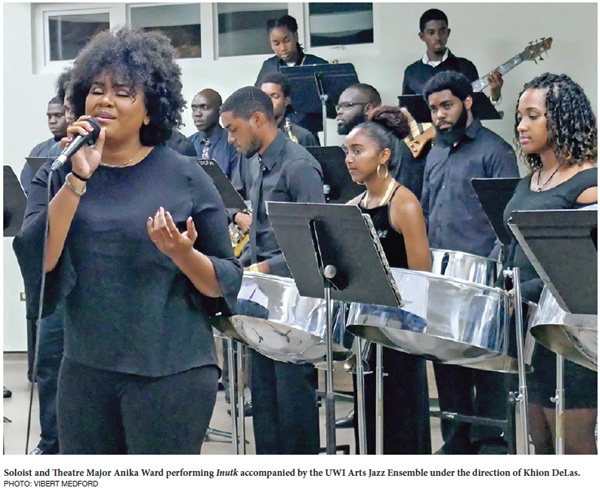|
June 2018

Issue Home >>
|

 Carmina Burana, the recent classical music production performed by students at the Department of Creative and Festival Arts (DCFA), was one of several final year UWI creative productions to challenge and inspire students in remarkable collaborations of performance artistry. The play The Crucible was another major public production, performed over two weekends in April. Carmina Burana, the recent classical music production performed by students at the Department of Creative and Festival Arts (DCFA), was one of several final year UWI creative productions to challenge and inspire students in remarkable collaborations of performance artistry. The play The Crucible was another major public production, performed over two weekends in April.
It is a little-known fact that the DCFA performs some 40 productions every year involving talented students and members of the public. These productions are all done in the absence of a proper theatrical performance stage on campus, yet remain consistently professional, world-class works of musicianship, theatre, dance and other combinations of performing arts done at different theatres and venues throughout the country as these become available for bookings.
DCFA Head of Department and Senior Lecturer Jessel Murray is justifiably proud of his students’ accomplishments, and has settled in well into the new administrative headquarters of the DCFA at the Cheesman Building in St Augustine, located in a quiet side road off Gordon Street. The new building opened for business just about a year ago, and already the confluence of different creative skills there is producing synergies and artistic collaborations that previously were quite rare.
Exploring indigenous Caribbean as well as international performance forms and genres, the DCFA aims to produce well-rounded students who can include interesting, challenging artistic work in their repertoire and performance portfolios as they move on to develop their careers.
DCFA students performed Carmina Burana, for instance, for one night on Sunday, April 8 this year at the Lord Kitchener Auditorium at the National Academy for the Performing Arts in Port of Spain. It was the culmination of much hard work and artistic collaboration spanning steelpan and piano music, choral singing, solos, percussion and dance. Carmina Burana is the Latin for "Songs from Beuern,” and is a secular oratorio or cantata composed by the German musician Carl Orff who was inspired by irreverant, satirical medieval poems from the 12th century. The word “cantata” comes from the Italian word “cantare”, to sing, and refers to a vocal composition with instrumental accompaniment in movements, often involving a choir. The form developed from Italian madrigals.
The songs and music of the Carmina Burana cantata can have an epic quality, soaring to crescendos or floating like haunting hymns in the air, with an undeniable sense of the marvels, beauties and tempestuous devils of the medieval imagination. It is a staple in the classical music repertoire. Students who may never have been previously exposed to or aware of this kind of music became educated about it through the DCFA this year, while also learning valuable skills in musical and vocal collaboration, rehearsal, timing, discipline and artistic production. The actual show combined forces of the UWI Arts Chorale, UWI Arts Percussion, UWI Arts Steel, and vocal soloists all conducted by Jessel Murray. It also included a special guest, the UWI Arts Dance Ensemble, while Dr Jeannine Remy conducted the UWI Arts Percussion in separate works for percussion and Khion De las led the UWI Arts Steel. It was a concert to remember.
 “I call the DCFA a coalition of units,” explained Jessel Murray in a recent interview at his office. “We have three performing units: music, theatre arts and dance. They interface with the public through performances. Then there is Visual Arts, which does exhibitions and work in fine arts and design. And then there is Carnival Studies, about the business, creativity and sustainability of Carnival, which holds two symposia a year, and which hosts the Old Yard every Sunday preceding Carnival Sunday.” “I call the DCFA a coalition of units,” explained Jessel Murray in a recent interview at his office. “We have three performing units: music, theatre arts and dance. They interface with the public through performances. Then there is Visual Arts, which does exhibitions and work in fine arts and design. And then there is Carnival Studies, about the business, creativity and sustainability of Carnival, which holds two symposia a year, and which hosts the Old Yard every Sunday preceding Carnival Sunday.”
“There is also a Masters in Creative Design and Entrepreneurship, available in any of the disciplines, open to people with a first degree as well as to any skilled person with a good portfolio or repertoire.”
Murray, in addition to his roles as musical conductor of choral and orchestral masterworks and musical theatre director of many productions for Must Come See Productions, has been leading the DCFA since 2011, and says it has been an extremely rewarding experience for him as the department raises its public profile and role as a creative thinktank. He spoke about the changes in the department in recent times as it moved to its new location and had to streamline ways of doing business, rolling out courses, internal staff redeployments, and communicating better with colleagues, partners and community members. And he expressed a deep gratitude and satisfaction with the new headquarters of the DCFA at Cheesman Avenue, while fervently hoping that Phase Two of DCFA development plans – the construction of a campus theatre – would soon take place. It is one of his long-held dreams.
One of the strengths of a DCFA music education, in particular, is the sheer number of ensembles which exist for students to hone their skills. Ensembles are performance units which music students are required to take part in, in addition to their regular studies. Under the umbrella brand of UWI ARTS, there are ensembles for choral singing, steelpan, percussion, guitar, jazz, Sinfonia, Indian classical music, wind instruments and African drumming. Students are assessed both during rehearsals throughout the year and during final event performances.
Murray said the school benefited this year from the generous bequest of a baby grand piano owned by Dr Anne Marion Osborne, a dedicated music lecturer and the first coordinator of UWI St Augustine’s music Unit. She worked at the DCFA for more than 25 years and died this January.
The new DCFA building headquarters at Cheesman Avenue opened for operations in August 2017 and includes two well-appointed dance studios, three teaching classrooms, two technical theatre rooms, and offices for lecturers and administrative staff. It was built as a public-private partnership with considerable generous funding help from Republic Bank as well as from The UWI. Plans for a campus theatre will likely follow a similar public-private partnership funding model.
|





